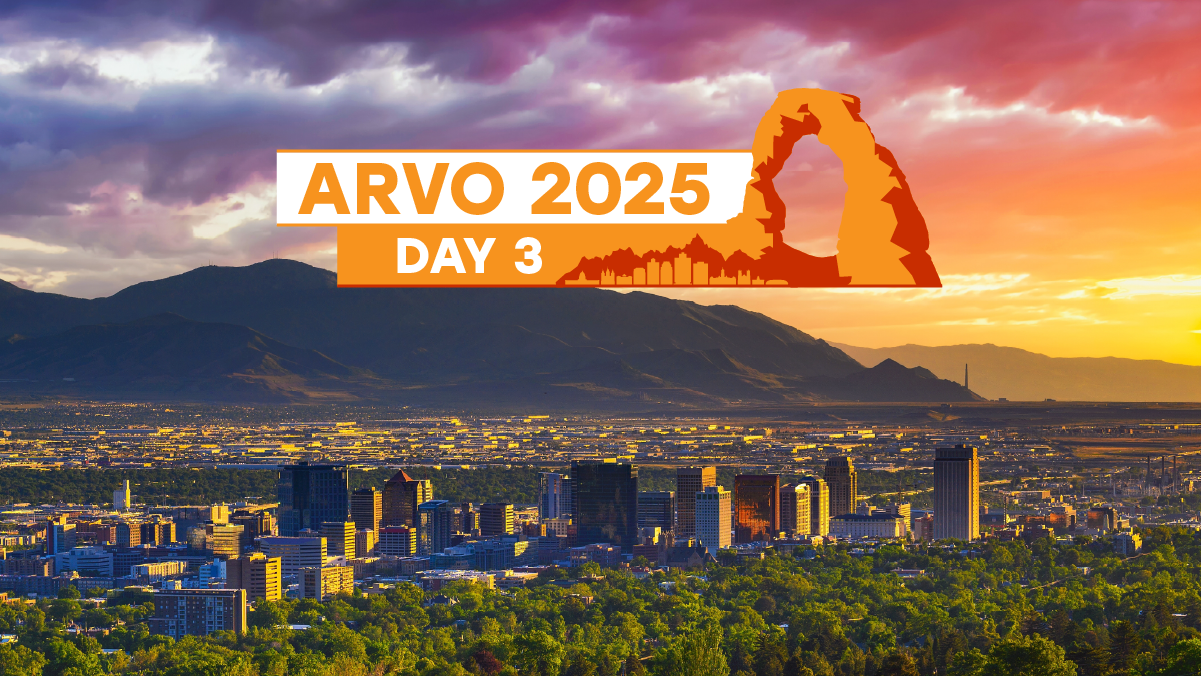We’ve hit the halfway point at ARVO 2025. Here’s what’s happening in Salt Lake City on a Day 3 packed with ophthalmic innovation.
It’s halftime here at The Association for Research in Vision and Ophthalmology 2025 Annual Meeting (ARVO 2025) at the Salt Palace Convention Center, and our coverage is rumbling on here for Day 3.
In this wrap-up, we’re recapping our highlight sessions, giving the latest industry updates here—and bringing you an exclusive interview with Nanoscope Therapeutics’ Dr. Subrata Batabyal on being one of the first 2025 Carl Camras Translational Research Award recipients from industry and the future of Nanoscope’s transformative regenerative retinitis pigmentosa candidate.
READ MORE: One Day, Three IRD Gene Therapy Triumphs
Nanoscope’s award-winning RP tech and reenergizing small drug developers
At a conference where academic researchers and clinicians typically claim the spotlight, Dr. Subrata Batabyal’s recognition as the 2025 Carl Camras Translational Research Award recipient is turning heads in Salt Lake City.
“I’m probably one of the first people to receive this prestigious award who comes from an industry background,” he said at the Nanoscope booth. “It’s a tremendous and humbling honor.”
The award has energized Dr. Batabyal and his team, who himself transitioned from academia to industry eight years ago. He mused about the impact such awards can have in inspiring young scientists working in industry to bring life-changing therapies to patients with highest unmet needs.
“It basically reenergizes small industry and drug developers to be recognized by internationally renowned organizations like ARVO,” he explained, drawing parallels between small drug developers working on life-changing therapies like Nanoscope’s and foundational academic research.
READ MORE: From Research to Practice
Behind the recognition lies Nanoscope’s revolutionary multi-characteristic opsin (MCO) gene therapy—a groundbreaking candidate for treating retinitis pigmentosa (RP) and other inherited retinal diseases. Unlike traditional approaches targeting specific genetic mutations, MCO therapy works regardless of a patient’s genetic profile—and, incredibly, is regenerative in nature, restoring sight to those who have lost vision.
“Our platform is mutation-independent and can treat a broad range of diseases because it does not rely on the underlying cause of loss of photoreceptor function,” Dr. Batabyal said. “We are trying to give vision back that was lost.”
The company has already completed pivotal Phase IIb/III trials for RP and is preparing to submit a rolling BLA with the FDA as soon as possible.
With a potential approval timeline targeting the second half of 2026, Dr. Batabyal feels both the excitement and responsibility that comes with pioneering new territory. “It demands more responsibility to carry forward the work,” he acknowledges, “Our team and clinicians are more motivated and hopeful than ever to bring this therapy to patients as soon as possible.”
Beyond their lead program, Nanoscope is expanding the platform to Stargardt disease and geographic atrophy, demonstrating the versatility of their optogenetic approach.
For Dr. Batabyal, the award represents more than personal achievement—it’s recognition that the future of vision restoration may come from unexpected places, including industry labs where science meets execution.
READ MORE: FDA Grants Fast Track Designation to Oral Treatment for Retinitis Pigmentosa
Highlight sessions
On to our highlight sessions for the day. First up, we’re covering a session on innovations in functional interpretations of genetic variants. Researchers in the session discussed how exploration of variants in a variety of diseases, from Fuchs’ dystrophy to glaucoma, is paving the way for groundbreaking translational research, better understanding of disease state, progression and underlying pathological mechanisms, and new avenues for therapeutics.
For our second highlight session, we’re looking at imaging—but not just the garden variety. Experts gathered to dive into adaptive optics imaging and its implications for clinical researchers understanding underlying disease mechanisms, clinical trials and more. Read now for the latest developments in how we see the eye, and what it could mean in the lab and beyond.
READ MORE: Translational Research at ARVO 2025
Industry updates
Opus Genetics’ OPGx-LCA5 for biallelic mutations in the LCA5 gene has been granted FDA regenerative medicine advanced therapy designation (RMAT) by the FDA, the company announced today. The announcement comes after they presented promising one-year data at ARVO 2025.
Ocugen is here with a poster containing two-year follow-up data for their mutation-agnostic retinitis pigmentosa gene therapy candidate OCU400. Their Phase III liMeliGhT trial is ongoing, and they are expecting BLA submission to the FDA in 2026.
Stealth Bio’s topical bevemipretide eye drop candidate (SBT-272) for dry AMD is showing promise down the road, and their poster on Phase I trial design is on display here in Salt Lake City. Could we be edging closer to expanding treatment options for the disease?
There’s also lots to love from OPTOS, which has come strapped with data for their ultrawide field fundus camera. They’re showcasing information on AI models for their RG and RGB retinal imaging for diabetic retinopathy, how primary care providers can use their UWF tech for detecting retinal issues in children, and more.
READ MORE: Find more updates from ARVO in our daily coverage hub here.
Editor’s Note: Reporting for this story took place during the annual meeting of The Association for Research in Vision and Ophthalmology (ARVO 2025) being held from 4-8 May in Salt Lake City, Utah, United States.



